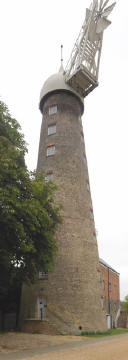| Tower mill,
Restored, but no sails yet. 80ft, 8 storey and basement. Said to be tallest
windmill in the country if you discount the cap. This mill was originally
about 97 feet high to the top of its ogee cap.
The mill had four double sided patent sails,
which unusually for Lincolnshire were carried on stocks in a poll end. The
fanstage was of the typical local type with the rear fly posts almost
vertical. Apart from the loss of its windshaft and original roof, the mill
is complete. Complete restoration is in hand. The Friends of Moulton Mill
are hoping to soon raise enough money to fit the sails, and have encouraged
local people to "sponsor" a sail shutter. When in fully working order again
with its (or her) four patent sails on, Moulton Mill will then be the
tallest working windmill in Great Britain and one of the tallest worldwide
In 2003, the mill featured on the first
series of BBC2's Restoration with Tim Wonnacott as its Celebrity Advocate.
The project won a large Heritage Lottery Fund grant, which, along with many
charity fundraising events has meant that the "Friends of Moulton Mill"
campaign has succeeded in raising enough money to restore and refurbish the
mill's structure and add a new cap. The new white ogee cap, (which weighs 14
tons) is visible for miles across the flat Fenland landscape. A café and shop
has also been built, and the mill has disabled access, allowing disabled
visitors to see some of the mill's inner workings.
The mill, built in 1822 by Robert King, was
a fully functioning windmill, grinding wheat and other products. However, on
December 20, 1894, the sails were damaged in a harsh gale and were removed
in 1895. Soon afterwards, a steam system was installed to power the mill. A.
W. Tindall leased it from the King family from 1890 until 1921. The
Biggadike family, who took over tenancy of the mill in 1924 continued to
mill, albeit small quantities of animal feed, until 1995.
You can find out more on the detailed
internal workings of this mill at
http://microsites.lincolnshire.gov.uk/windmills/section.asp?catId=3415

On our visit
We found a very large mill, less sails. It
was difficult to photograph due to its size and the lack of thought in
allowing a large tree to grow right in front of it in recent years. This
meant that the only options were close up and producing images that slope
back badly. The top images I have attempted to correct the perspective in
Photoshop, but its not really worked. The second image down you will see is
better from further back, but has the tree in the way. The lower shot is
from further up, and there are again limits in the image that can be
obtained before you run into obstacles.
The tree that has been stupidly put in the
way is the problem, and at the moment stops any really good photographs
being taken, as well as people getting a good view of this mill that so much
public money has been spent on. As the tree is deciduous (not evergreen) if a winter photo was taken then it may be more twigs than solid
green lump. It may be that when the sails are put on they will remove
the tree, or it may be that once fully open that they have to see visitor
numbers are poor to realise it needs dealing with. Of course if they need a
new photo to go for more grants then they may also discover the problem.
Of course the other problem is likely to be
that unless they deal with this tree now, some people will get attached to
and and it will then be far more difficult to deal with later.
At the moment its not worth the trip to
take it, let us know if you do visit and the tree has been removed. |
  |